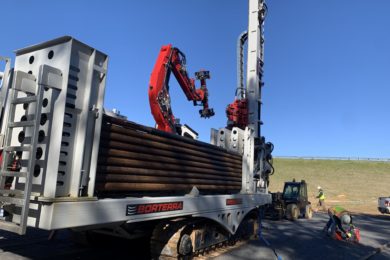The labour shortage wreaking havoc across North America has hit the drilling industry as hard as any. One recent advance that promotes workplace safety also helps solve the workplace shortage. It’s called RodBot™ and in most situations it reduces the number of people needed on a drill rig down to a single operator. MEDATech’s Borterra drilling division created the hydraulic, robotic pipe handler specifically for loading and unloading drill rods and casing.
RodBot is suitable for mining, construction and the oil & gas industry, as it can be adapted to work on virtually any piece of drilling equipment. Mounted to a drill rig, pipe truck or on a skid, RodBot is an easy tool for operators to master thanks to its computer-assisted controls with embedded collision-avoidance capabilities. Multiple units are either working in the field (Alabama Power) or being commissioned for a variety of applications, including a new exploration-drilling unit.
Mechanised equipment, better training and safety protocols have greatly reduced the instance of injury in drilling over the past 20 years. Until now, one big exception was handling rod and casing: it accounts for over 90% of drilling-related injuries. The manual work of inserting and extracting rod and casing typically involves a crew of two or three moving heavy metal cylinders from rack to drill head or vice-versa.
“Moving drill pipe in and out of the mast can be the bottleneck in the drilling process,” says Scott Dalrymple, MEDATech Senior Design Engineer & Product Manager for Borterra. “Until now, there has been no mechanised system that can do it as quickly as people can. But the very nature of the job makes it fraught with potential for injury.”
Because of their weight, manually-loaded ITH rod and casing is typically limited to 5 ft lengths, meaning that 60 pieces of each are needed for a 120 ft shaft. Handling that many pieces of rod is hard, time-consuming work with a lot of potential for accidents.
RodBot eliminates 95% of manual rod handling. “What that means is that only in exceptional circumstances do rigs need more than a single operator. With RodBot, pipe and casing is picked up or put into the cradle with a precisely-controlled grapple. Once the operator has manually steered the pipe or casing to or from the mast, they can essentially hit ‘repeat’ and RodBot adds or removes rod or casing as needed.”
“Robotic lifting and transporting has become the norm in many industries,” says Dalrymple. “The challenges of working in remote locations with diesel-only power have made it difficult to transfer car assembly plant-type robotics into a drilling environment.” MEDATech says RodBot is industry-leading in that it’s 100% hydraulic-robotic. The technology is similar to what the car companies have been employing on lines for over two decades, but in a remote setting. “Bringing proven, safer technologies from manufacturing to drilling only makes sense,” says Dalrymple.
RodBot has three control modes: from Full Manual, where the operator controls movement every step of the way, to Autonomous Control with Collision Avoidance. In Full Manual Control the operator has manual control of each moving element of the arm. With Tip Control, computer assistance allows the operator to control the arm moving the drill pipe in a linear motion. Single-axis input on the joystick translates to the pipe, moving in a straight line either vertically or horizontally out from the arm base. With Autonomous Control, the RodBot moves along a path determined by the operator and/or automatically adapted to the current mast position. The operator has hands-on control and can start/stop at any time if safety is ever in question.
RodBot has what robotics engineers call “go” and “no-go” areas: zones within the arm’s reach in which it’s safe to operate and zones where it’s not. That includes defining zones where there is equipment in the way and must be avoided. With RodBot, an operator can program a starting point, an ending point, and the robot will calculate the most efficient path, including navigating around any defined obstacles, using collision-avoidance software built into the robotic operating software.
As a separate unit, RodBot can mount to an existing drill rig or be set beside the drill on a skid. The operator can define and modify no-go zones for both the path taken by the robotic arm and exclusionary zones for the drill setup at each new location. “The rod movements are consistently fast,” explains Dalrymple. “The learning curve is quick and the machine minimizes the potential for human error. It takes less skill to operate than your average video game.”
There’s no need to wait for drill rig replacement to start using RodBot, as it can be retrofitted onto most rig configurations. “Borterra can also supply a dedicated hydraulic powerpack (diesel, gas, or electric), help integrate your existing hydraulic system, or supply you with the information you need to do it on your own.”










